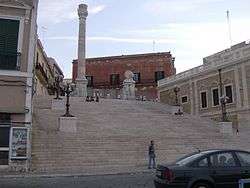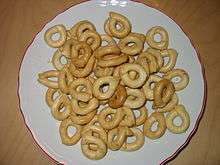Brindisi
| Brindisi | |
|---|---|
| Comune | |
| Comune di Brindisi | |
|
The Roman column marking the end of the ancient Via Appia in Brindisi. | |
 Brindisi Location of Brindisi in Italy | |
| Coordinates: 40°38′N 17°56′E / 40.633°N 17.933°E | |
| Country | Italy |
| Region |
|
| Province / Metropolitan city | Brindisi (BR) |
| Frazioni | Tuturano |
| Government | |
| • Mayor | Angela Carluccio |
| Area | |
| • Total | 333 km2 (129 sq mi) |
| Elevation | 15 m (49 ft) |
| Population (1 January 2016) | |
| • Total | 88,302 |
| • Density | 270/km2 (690/sq mi) |
| Demonym(s) | Brindisini |
| Time zone | CET (UTC+1) |
| • Summer (DST) | CEST (UTC+2) |
| Postal code | 72100 |
| Dialing code | 0831 |
| Patron saint | St. Theodore of Amasea and St. Lawrence of Brindisi |
| Saint day | First Sunday in September |
| Website | Official website |
Brindisi (Italian pronunciation: [ˈbrindizi]; in the local dialect: Brìnnisi; Latin: Brundisium)[1] is a city in the region of Apulia in southern Italy, the capital of the province of Brindisi, on the coast of the Adriatic Sea. Historically, the city has played an important role in trade and culture, due to its strategic position on the Italian Peninsula and its natural port on the Adriatic Sea. The city remains a major port for trade with Greece and the Middle East. Brindisi's most flourishing industries include agriculture, chemical works, and the generation of electricity.
Geography
Brindisi is situated on a natural harbor, that penetrates deeply into the Adriatic coast of Apulia. Within the arms of the outer harbor islands are Pedagne, a tiny archipelago, currently not open and in use for military purposes (United Nations Group Schools used during the intervention in Bosnia). The entire municipality is part of the Brindisi Plain, characterized by high agricultural uses of its land. It is located in the northeastern part of the Salento plains, about 40 kilometres (25 mi) from the Itria Valley, and the low Murge. Not far from the city is the Natural Marine Reserve of the World Wide Fund for Nature of Torre Guaceto. The Ionian Sea is about 45 kilometres (28 mi) away.
Territory
The territory of Brindisi is characterized by a wide flat area from which emerge sub deposits of limestone and sand of marine origin, which in turn have a deeper level clay of the Pleistocene era, and an even later Mesozoic carbonate composed of limestone and soils. The development of agriculture, has caused an increase in the use of water resources resulting in an increase of indiscriminate use.[2]
Climate
Brindisi enjoys a Mediterranean climate (Köppen: Csa).
| Climate data for Brindisi | |||||||||||||
|---|---|---|---|---|---|---|---|---|---|---|---|---|---|
| Month | Jan | Feb | Mar | Apr | May | Jun | Jul | Aug | Sep | Oct | Nov | Dec | Year |
| Record high °C (°F) | 20.6 (69.1) |
22.0 (71.6) |
23.6 (74.5) |
27.4 (81.3) |
35.0 (95) |
43.4 (110.1) |
44.4 (111.9) |
43.8 (110.8) |
37.0 (98.6) |
31.6 (88.9) |
27.0 (80.6) |
22.4 (72.3) |
44.4 (111.9) |
| Average high °C (°F) | 12.9 (55.2) |
13.0 (55.4) |
15.7 (60.3) |
18.3 (64.9) |
23.2 (73.8) |
27.3 (81.1) |
29.9 (85.8) |
29.9 (85.8) |
26.1 (79) |
21.9 (71.4) |
17.9 (64.2) |
14.1 (57.4) |
20.85 (69.52) |
| Daily mean °C (°F) | 9.8 (49.6) |
9.9 (49.8) |
12.1 (53.8) |
14.7 (58.5) |
19.1 (66.4) |
23.3 (73.9) |
26.1 (79) |
26.0 (78.8) |
22.4 (72.3) |
18.5 (65.3) |
14.4 (57.9) |
11.1 (52) |
17.28 (63.11) |
| Average low °C (°F) | 7.2 (45) |
7.1 (44.8) |
9.0 (48.2) |
11.3 (52.3) |
15.3 (59.5) |
19.5 (67.1) |
22.1 (71.8) |
22.3 (72.1) |
19.1 (66.4) |
15.5 (59.9) |
11.6 (52.9) |
8.7 (47.7) |
14.06 (57.31) |
| Record low °C (°F) | −6.4 (20.5) |
−2.4 (27.7) |
−1.6 (29.1) |
2.0 (35.6) |
5.6 (42.1) |
9.8 (49.6) |
12.4 (54.3) |
13.8 (56.8) |
9.0 (48.2) |
4.0 (39.2) |
1.0 (33.8) |
−1 (30) |
−6.4 (20.5) |
| Average precipitation mm (inches) | 65.3 (2.571) |
79.5 (3.13) |
64.2 (2.528) |
45.9 (1.807) |
23.6 (0.929) |
14.8 (0.583) |
12.1 (0.476) |
23.7 (0.933) |
49.4 (1.945) |
76.8 (3.024) |
84.5 (3.327) |
65.1 (2.563) |
604.9 (23.816) |
| Average precipitation days (≥ 1 mm) | 8.2 | 8.3 | 7.1 | 6.2 | 3.8 | 2.3 | 1.6 | 2.6 | 4.6 | 6.5 | 7.7 | 7.8 | 66.7 |
| Average relative humidity (%) | 78 | 75 | 74 | 72 | 70 | 71 | 70 | 72 | 74 | 76 | 77 | 77 | 73.8 |
| Mean monthly sunshine hours | 120.9 | 124.2 | 164.3 | 201.0 | 266.6 | 297.0 | 334.8 | 303.8 | 248.0 | 192.2 | 132.2 | 111.6 | 2,496.6 |
| Source #1: Servizio Meteorologico (1971–2000 data)[3] | |||||||||||||
| Source #2: Servizio Meteorologico (1961–1990 data on humidity and sunshine)[4] | |||||||||||||
History
Ancient times
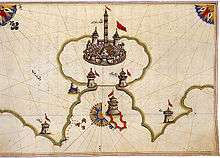
There are several traditions concerning its founders; one of them claims that it was founded by the legendary hero Diomedes.
Brindisi was an Ancient Greek settlement predating the Roman expansion. The Latin name Brundisium comes from the Greek Brentesion (Βρεντήσιον) meaning "deer's head", which refers to the shape of the natural harbor. In 267 BC (245 BC, according to other sources) it was conquered by the Romans.[5] In the promontory of the Punta lands, which is located in the outer harbor have been identified as a Bronze Age village (16th century BC) where a group of huts, protected by an embankment of stones, yielded fragments of Mycenaean pottery. Herodotus spoke of the Mycenaean origin for these populations. The necropolis of Tor Pisana (south of the old town of Brindisi) returned Corinthian jars in the first half of the 7th century BC. The Brindisi Messapia certainly entertained strong business relationships with the opposite side of the Adriatic and the Greek populations of the Aegean Sea.
After the Punic Wars it became a major center of Roman naval power and maritime trade. In the Social War it received Roman citizenship, and was made a free port by Sulla. It suffered, however, from a siege conducted by Caesar in 49 BC (Bell. Civ. i.) and was again attacked in 42 and 40 BC.
The poet Pacuvius was born here about 220 BC, and here the famous poet Virgil died in 19 BC. Under the Romans, Brundisium – a large city in its day with some 100,000 inhabitants – was an active port, the chief point of embarkation for Greece and the East, via Dyrrachium or Corcyra. It was connected with Rome by the Via Appia and the Via Traiana. The termination of the Via Appia, at the water's edge, was formerly flanked by two fine pillars. Only one remains, the second having been misappropriated and removed to the neighbouring town of Lecce.
Middle Ages and modern times
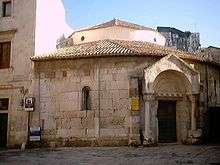
Later Brindisi was conquered by Ostrogoths, and reconquered by the Byzantine Empire in the 6th century AD. In 674 it was destroyed by the Lombards led by Romuald I of Benevento, but such a fine natural harbor meant that the city was soon rebuilt. In the 9th century, a Saracen settlement existed in the neighborhood of the city, which had been stormed in 836 by pirates.
In 1070, it was conquered by the Normans and became part of the Principality of Taranto and the Duchy of Apulia, and was the first rule of the Counts of Conversano and then, after the baronial revolt of 1132, city-owned by the will of Roger II of Sicily, the city recovered some of the splendor of the past during the period of the Crusades, when it regained the Episcopal See, saw the construction of the new cathedral and a castle with an important new arsenal, became a privileged port for the Holy Land. It was in the cathedral of Brindisi that the wedding of Norman Prince Roger III of Sicily took place, son of King Tancred of Sicily. Emperor Frederick II, the heir to the crown of Jerusalem and Isabella of Brienne ( 9 November 1225 ) [6] started from the port of Brindisi in 1227 for the Sixth Crusade[7] Like other Pugliese ports, Brindisi for a short while was ruled by Venice, but was soon reconquered by Spain.
A plague and an earthquake struck the city, in 1348 and 1456.
Brindisi fell to Austrian rule in 1707–1734, and afterwards to the Bourbons. Between September 1943 and February 1944 the city functioned as the temporary capital of Italy.
Brindisi is also noteworthy because it hosted King Victor Emmanuel III, Pietro Badoglio and a part of the Italian armed forces command in September 1943 after the armistice with Italy.
In the 21st century, Brindisi serves as the home base of the San Marco Regiment, a marine brigade originally known as the La Marina Regiment. It was renamed San Marco after its noted defense of Venice at the start of World War I.[8]
On 19 May 2012, a bomb, made of three gas cylinders, detonated in front of a vocational school in Brindisi, killing a 16-year-old female student. (BBC) (La Repubblica)
Etymology
The name comes through the Latin Brundisium through the Greek Brentesion and Messapi Brention meaning “head of deer”.[9] The city's name appears, therefore, refer to the shape of the port which recalls the shape of the head of the animal.
Heraldry
The emblem of the city of Brindisi, relates to certain unique characteristics of the ancient city of Brindisi, some of them still visible today. The head of deer derives from the Messapic name of the city Brention, name inspired by the shape of the port city, which is reminiscent, of the antlers of a stag that is still clearly visible in satellite photos, which show the two racks, to the east and west, in which the port is divided. The emblem also contains the so-called "terminal columns" of the Appian Way.
Main sights
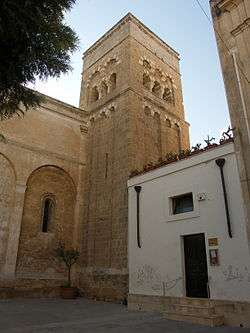
- The Castello Svevo or Castello Grande ("Hohenstaufen Castle" or "Large Castle"), built by Emperor Frederick II. It has a trapezoid plan with massive square towers. Under the Crown of Aragon four towers were added to the original 13th-century structure. After centuries of being abandoned, in 1813 Joachim Murat turned it into a prison; after 1909 it was used by the Italian Navy. During World War II it was briefly the residence of King Victor Emmanuel III.
- The Aragonese Castle, best known as Forte a Mare ("Sea Fort"). It was built by King Ferdinand I of Naples in 1491 on the S. Andrea island facing the port. It is divided into two sections: the "Red Castle" (from the color of its bricks) and the more recent Fort.
- Two ancient Roman columns, symbols of Brindisi. They were once thought to mark the ending points of the Appian Way, instead they were used as a port reference for the antique mariners. Only one of the two, standing at 18.74 metres (61.5 ft), is still visible. The other crumbled in 1582, and the ruins was given to Lecce to hold the statue of Saint Oronzo (Lecce's patron), because Saint Oronzo was reputed to have cured the plague in Brindisi.
- the Duomo (cathedral), built in Romanesque style in the 11th–12th centuries. What is visible today is the 18th-century reconstruction, after the original was destroyed by an earthquake on 20 February 1743. Parts of the original mosaic pavement can be seen in the interior.
- Church of Santa Maria del Casale (late 13th century), in Gothic-Romanesque style. The façade has a geometrical pattern of gray and yellow stones, with an entrance cusp-covered portico. The interior has early-14th-century frescoes including, in the counter-façade, a Last Judgement in four sections, by Rinaldo da Taranto. They are in late-Byzantine style.
- Church of San Benedetto, in Romanesque style. Perhaps built before the 11th century as part of a Benedictine nunnery, it has a massive bell tower with triple-mullioned windows and Lombard bands. A side portal is decorated with 11th-century motifs, while the interior has a nave covered by cross vaults, while the aisles, separated by columns with Romanesque capitals, have half-barrel vaults. The cloister (11th century) has decorated capitals.
- Portico of the Templars (13th century). Despite the name, it was in reality the loggia of the bishop's palace. It is now the entrance to the Museo Ribezzo.
- the Fontana Grande (Grand Fountain), built by the Romans on the Appian Way. It was restored in 1192 by Tancred of Lecce.
- Piazza della Vittoria (Victory Square). It has a 17th-century fountain.
- Church of Santa Maria degli Angeli (1609).
- Church of the Sacred Heart.
- Church of San Giovanni al Sepolcro, with circular plan, dating from the 12th century.
- Church of the Santissima Trinità (or Santa Lucia, 14th century). It has a late 12th-century crypt.
- the Monument to Italian Sailors
Natural areas
Within the territory of the town of Brindisi environmental protected areas are located, some newly established:
- The Regional Natural Park of Punta della Contessa Salt: wetland of 87 hectares (214 acres) between Capo di Torre Cavallo and Punta della Contessa
- The Regional Nature Reserve Forest Cerano: a protected natural area that falls within the territory of Brindisi and San Pietro Vernotico;
- The Regional Nature Reserve Bosco of Santa Teresa and Lucci: it is a protected natural area composed of two forests whose name it bears. With the EU Directive 92/43 EEC, was included in the list of Sites of Community Importance (SCI) ;
- The Marine Nature Reserve Guaceto Tower: falling mostly in the municipality of Carovigno, are managed by a consortium which includes the municipalities of Brindisi, Carovigno and the WWF.
 Brindisi Harbour
|
Demography
Migration
Brindisi has been the subject of extensive emigration during the 20th century, as well as all cities in the South. Emigration focused mainly on the lower strata of society who abandoned the countryside. Emigration can be traced in two great waves. The first, which was at its peak in the years immediately before and after the First World War, was almost exclusively to the Americas (and mostly to the United States, Argentina, and Brazil). The second wave of migrants from Apulia headed instead for Northern Europe after the Second World War. Attracted by the industrial development of some northern areas of the country, many Apulian migrants also settled in the Piedmont and Lombardy regions of northern Italy, and particularly in Milan. Since the 1960s, when the large petrochemical companies were joined by mechanical, naval, and aviation corporations, Brindisi was able to create employment opportunities for technicians and workers. The city experienced a small regional immigration, attracting families from neighboring provinces and regions. Another important chapter in the demography of the town was definitely the exodus of people from Albania in 1990–1991, which actually lasted almost a decade and led to the port of Brindisi receiving waves of Albanian immigrants.[10]
Ethnic groups
The largest non-Italian ethnic community is Albanian. The number of those who decided to stay in the city, however, is negligible in light of the number of immigrants who migrated. Brindisi remains the first step towards western Europe for displaced people from the Balkans.[11]
The large number of Americans is largely due to a U.S. Air Force station, between Brindisi and San Vito dei Normanni that operated throughout the second half of the 20th century. Although the base is no longer operational for years, many soldiers have decided to stay.[11]
The British presence is the result of a recent phenomenon of families from Northern Europe, especially English and Irish, settling in the region. Many such settlers are pensioners, buying villas in the Brindisi countryside. This phenomenon is relatively recent in Apulia, is known as "Salentoshire", a playful neologism along the lines of "Chiantishire" on the consolidation of British tourism in Tuscany.[11]
Languages and dialects
The Brindisi dialect is a variant of Salentino and, although there are minor differences between the various municipalities, the root remains unchanged. It is spoken not only in Brindisi, but in some towns of the province of Taranto. The Brindisi also affects some dialects north of Lecce in the south[12]
Religion
Brindisi, along with Ostuni, is home of the Archdiocese of Brindisi-Ostuni (Archidioecesis Brundusina-Ostunensis in Latin ), home of the Roman Catholic Church suffragan of Archdiocese of Lecce and part of the ecclesiastical region of Apulia.[13] The diocese was erected in the 4th century, its first bishop was St. Leucio of Alexandria. In the 10th century following the destruction of the city by the Saracens, the bishops established their residence in Oria. It was in this century that established the Diocese of Ostuni, first joined the Diocese of Conversano-Monopoli and likely heir to the ancient diocese of Egnatia. On 30 September 1986, by decree of the Congregation for Bishops, the Archdiocese of Brindisi and Ostuni diocese were united in the Archdiocese of Brindisi-Ostuni plena. The new diocese was recognized civilly 20 October 1986, by decree of the Ministry of Interior . It has a living presence of the ancient Orthodox Church with the parish of St. Nicholas of Myra Byzantine Rite. The rite of the Greek presence in Brindisi has long been established since the rule of the Byzantine Empire with a strong spread of the Basilian monks.[14] The Jews were a small but industrious community from 53 AD until the second half of the 16th century. The new Albanian migration has led to the recurrence of some Islamic religious presence.
Culture
Traditions and folklore
Significant in Brindisi is the cult of Tarantismo that combines pagan and Christian tradition. In the past it was believed that women who showed forms of hysteria were infected by the bite of a Lycosa tarantula. The only known remedy was to dance continuously for days, so that the poison did not cause greater effect. Through music and dance was created a real exorcism in musical character. Each time a tarantato exhibited symptoms associated with Taranto, the tambourine, fiddle, mandolin, guitar and accordion players went in the house of the tarantato and began to do to play the pinch music with frenetic rhythms. The Brindisi pinch, as opposed to Lecce, is devoid of Christian references [15] and a therapeutic repertoire and musical detail.[16]
Education
Libraries
The Provincial Library is a public library located in Commenda avenue. It has over 100,000 books and an extensive newspaper archive and participates in the National Library Service. Inside a modern auditorium, a media office and the secretariats of the university offices of Bari and Lecce operate. The Archbishop Annibale De Leo Library is a prestigious public library housed in the Seminary of Brindisi, in Piazza Duomo. Founded in 1798 by archbishop of Brindisi Annibale De Leo, with an endowment of about 6,000 volumes, today it has over 20,000 volumes, 17 incunable, over 200 16th-century manuscripts. These include some rare works, and various manuscript collections.[17]
University
The University of Salento Brindisi has social sciences, politics and geography faculty with courses in Sociology, Social Services and Political Science. The University of Bari has courses in Business Administration, Management and Consulting, Economics, Maritime and Logistics, Information Technology, Design, Nursing and Physiotherapy.
Museums
The "F. Ribezzo"Provincial Archaeological Museum is located in Piazza Duomo and has many large rooms, providing visitors with six sections: epigraphy, sculpture, the antiquarium, prehistoric, coins, medieval, modern and bronzes of Punta del Serrone. The Giovanni Tarantini Diocesan Museum is newly established and is housed in the Palazzo del Seminario. It has a collection of paintings, statues, ornaments and vestments from the churches of the diocese. Particularly important is the silver embossed Ark that has the remains of St Theodore of Amasea and a 7th-century pitcher, in which one can recognize the wedding at Cana. The Ethnic Salento Agrilandia Museum of Civilization offers tourists the chance to see many statues in wood and stone. It also features agriculture and interesting tools with the rural culture.[16]
Music and theatre
Music and theater in Brindisi have never featured significantly in the cultural life of the city. Having never hosted theatrical and musical training institutes, the city supports amateur companies. Over the past decade the city has developed and consolidated non-amateur theater companies, some dealing with theater for research and actor training. These companies have developed several socio-cultural projects for the promotion of the theater for people with disabilities. The same group of companies has produced six shows.[16]
The most important musician from Brindisi is Stefano Miceli, an Italian classical pianist and conductor, globally known for his concerts at Carnegie Hall in New York City, Berlin Philharmonie, Gewandhaus in Leipzig, Forbidden City Concert Hall in Beijing and at the Great Hall in Melbourne. Also a Steinway Artist, he was given a silver medal by the President of Italy Napolitano and has been a visiting and distinguished professor at Boston University, Tanglewood Institute, the University of New Mexico and at many other academical music schools around the world.
Notable Brindisini
- Marcus Pacuvius (Brundisium, 04.29.220 b.C. – Tarentum, 02.07 130 b.C.) Roman artist, poet and dramatist, nephew of Quintus Ennius.
- Margaritus of Brindisi (also Margarito; Italian Margaritone or Greek Megareites or Margaritoni [Μαργαριτώνη]: c. 1149–1197), called the new Neptune, was the last great ammiratus ammiratorum (Grand Admiral) of Sicily. First Count of Malta, Prince of Taranto and Duke of Durazzo.
- St. Lawrence of Brindisi: (born Giulio Cesare Russo, Brindisi, 22 July 1559 – Santa Maria de Belém (Lisbon), 22 July 1619 ) was a priest of the Italian Order of Friars Minor Capuchin. Proclaimed a saint by Pope Leo XIII in 1881, in 1959 was ranked among the Doctors of the Church.
- Giustino Durano (Brindisi 1923 – Bologna 2002 ), actor
- Eugenio Barba (Brindisi, 1936 ), director
- Franco Testini (Brindisi, 7 October 1966) also known as Venerable Shi Yanfan is the first Western Buddhist Monk ever to be ordained at the renowned Songshan Shaolin Temple of China. He is currently the appointed Cultural Ambassador for the Songshan Shaolin Temple.
- Antonio Benarrivo (Brindisi, 21 August 1968 ) is a former soccer player who held the role of defender.
- Stefano Miceli (Brindisi, 14 April 1975 ) pianist and conductor
- Flavia Pennetta (Brindisi, 25 February 1982 ) is a tennis player, reached 6th place in world rankings after winning the 2015 US Open.[18]
- Cosimo Aldo Cannone (Brindisi, 20 March 1984) is a driver of Powerboating, 2 time world champion, in 2007 and 2008.
- Antimo Iunco (Brindisi, 10 June 1984 ) is a player for Torino and has the role of attacker.
- Daniele Vantaggiato (Brindisi, 10 October 1984 ) is a soccer player for Calcio Padova and has the role of attacker .
Media
Radio
Radio station, CiccioRiccioBrindisi, is heard throughout Apulia, Basilicata, parts of Molise, Campania and Calabria. Radio Dara that started in a workshop, founded in 1980, now broadcasts across the province.[19]
As for the press, the La Gazzetta del Mezzogiorno publishes the Brindisi Journal. The Nuovo Quotidiano di Puglia, Salento's newspaper, also covers Brindisi. Senzacolonne, which was founded in 2004, is the only one with a central editorial office in Brindisi.[16] "The Nautilus" national scientific magazine based in Brindisi, reports on the sea, ports, transport and recreational boating. Other newspapers that have their headquarters in the city are BrindisiSera and "Brindisi News".
Television
Brindisi is home to the television stations Teleradio Agricoltura Informazione and Puglia TV, which began broadcasts in January 1988 in Brindisi.
Cuisine
Brindisi's cuisine is a simple with ingredients used, starting with flour or unrefined barley, which is less expensive than wheat. Vegetables, snails, and bluefish figure prominently into its cuisine. Among the recipes are worth mentioning in particular "Pettole"(fried yeast dough, sweet or savory to taste stuffed maybe with cod or anchovy, with cauliflower or broccoli), "Patani tajedda rice and mussels" (rice, potatoes and mussels), soup, fish, mashed potatoes with fava beans, broad beans and mussels, and "Racana mussels".[20]
Beverages, spirits, liquors
Almond milk: made by infusing water with the finely chopped almonds and then squeezing the same to expel the "milk". The region of Apulia has entered the milk of almonds in its list of traditional Italian food products . Limoncello: a liquor made from the peel of fresh lemons and enriched with water, sugar and alcohol.[20]
Cheese
Brindisi cheeses are mostly from sheep, due to the significant ranching of sheep and goats. In the summer they produce ricotta, which can be eaten fresh or matured for a few months so that it has a stronger flavor. Typical of the winter season are the Pecorino, ricotta and strong ricotta (or cottage cheese). It is used to flavor spaghetti sauce or spread on bruschetta.[20] Fresh popular cheeses are burrata, the junket, the Manteca, mozzarella or Fior di latte.
Vegetable products, processed or unprocessed
Vegetables are the true protagonist of the traditional diet of Salento. Depending on season, are the tops of turnips, various types of cabbage, the beet greens from the thistle, peppers, eggplant and zucchini (all served sun-dried or in olive oil), and artichokes. There are also wild vegetables used in traditional cooking such as chicory, dandelion (or zangune), wild asparagus), the Wild mustard, the thistle, the lampascioni also called pampasciuni or pampasciuli, and capers.[20] Frequent, in the Brindisi kitchen, is the use of green or white tomatoes: mainly used for tomato sauce but they are also consumed in olive oil, after a process of natural drying. Significant is also the consumption of green and black olives, crushed or in brine. Finally, legumes such as beans, peas and Vicia faba, eaten fresh or dried in the spring and during the winter season. Among the dishes prepared with fruit are quince, baked figs and dried figs (prepared with a filling of almonds), jam with orange and lemon, and fig jam.[20]
Pasta, pastry and confectionery
Pasta and bread is made with unrefined flour, and thus takes on a dark colour. Durum wheat is mixed with traditional meal. Special local dishes include lasagna with vegetables, cavatelli, orecchiette (stacchioddi in Brindisi dialect) and ravioli stuffed with ricotta.
In breadmaking, local custom favours the use of durum wheat, bread flour and barley bread. For bread made with yeast (called criscituni) and cooked on an oven stone, Brindisi bakers use bundles of olive branches to give the bread a particular scent. One type of traditional bread is made with olives (called puccia). It is made with a much more refined wheat flour than for ordinary bread, to which are added black olives.
Also important are frisella, a sort of dehydrated hard bread which can be stored for a long time, and tarallini, also easily stored for long periods. The pucce and uliate cakes are also typical. Among local desserts the central place is occupied by almond paste, obtained by grinding shelled almonds and sugar. Another speciality is cartellate, a thin strip of pastry, made with flour, oil and wine, wrapped on itself to form a sort of "pink" choreographed with openings, which will then be fried in oil.[20]
Wine
In the area of Brindisi are produced Aleatico di Puglia Doc, Ostuni Doc, Brindisi Rosso DOC, Rosato Brindisi DOC and Puglia IGT.[20] Some grape varieties grown in Brindisi include:
The Brindisi DOC produces both red and rose wines from grapes limited to a harvest yield of 15 tonnes/ha and must produce a wine with a minimum 12% alcohol level. The wines are usually blends made predominantly from Negaroamaro and Malvasia Nera but Sangiovese is allowed to compose up to 10% of the blend with Montepulciano allowed to compose up to another 20% (or 30% if Sangiovese is not included). If it is to be a Reserva, the wine is aged a minimum of 2 years before release and must attain a minimum alcohol level of 12.5%.[21]
Events
- The day of Corpus Christi.
- The Procession to the beach of San Lorenzo and San Teodoro, on the first Saturday of September .
- The Feast of San Teodoro: Feast with candles, food stands, music, fireworks, in the first week of September.
Geography anthropogenic
Roman period
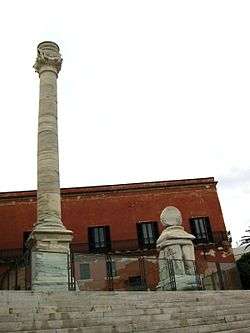
From an urban point of view [58] [59], the city's earliest signs of human settlement are on the promontory of Punta Terre, a coastal area outside the port. As a Roman colony ( 244 BC ), the city experienced a major urban expansion that ensued economic and social development. According to Pliny the Elder, Brindisi was one of the most important Italian cities.
Middle Ages
During the Middle Ages, Brindisi suffered a sharp decline, after it was devastated by the Goths in the 6th century; Procopius describes it as a small city without defensive walls. The town shrank to a smaller area, probably around the San Leucio temple, outside the old town. The port was abandoned for several centuries. The rebirth came with the Byzantine domination (11th century ) and especially with the Normans and the Swabians (12th and 13th century), when it became a prime port for the Crusades. The city was divided into three districts or "pittachi": Santo Stefano (in the vicinity of the columns), Eufemia (in Santa Teresa) and San Toma (in the area of Saint Lucia). Under the Aragonese and the Spanish kings, the main efforts were directed mainly around the ramparts (walls, castle and sea fort to provide relief from mostly the Greeks, Albanians and Slavs.[14]
Modern era
Only through the reopening of the Pigott channel (1775), the city experienced a new impetus and reopened traffic with the East mainly due to the establishment of the Suez Canal at the end of the 19th century.[14]
Contemporary era
Demographic development in the 20th century led to the modern city overlying the ancient one, at the cost of the demolition of the neighbourhoods around San Pietro degli Schiavoni, Teatro Verdi, and the Clock Tower. Today urban planning demands that settlements of significant architectural impact are built outside the city centre. The city has now expanded beyond the walls of the historic centre to form the new suburbs of Commando, Capuchins, Sant'Angelo (1950–1970 ) and St. Clare, St. Elias, and Bozzano (1980–2000).[14]
Economy
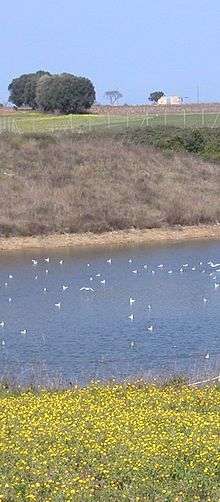
The development of industry led to radical changes in the Brindisi economy and consequent development along the coast. Taking advantage of the location of the port, Brindisi is also a major seaport for Greece and Turkey.
Agriculture
Brindisi agriculture includes horticulture, viticulture, fruit and olives. The area that marked the territory for centuries is based on the culture of almonds, olives, tobacco, artichokes, and grain. Livestock consists of cattle, goats and sheep.
Industry
Industry in Brindisi is mainly identified with the chemical and aerospace industry.
Chemical
The chemical industry, in its various forms (food processing, energy, and pharmaceutical) is highly developed in the territory of Brindisi. The Federchimica association recognizes Brindisi as an industrial chemical center.
The various establishments of ENI, located as Polimeri Europa, Snam and EniPower are placed in the petrochemical complex of Brindisi, on the outskirts of the city, overlooking the Adriatic Sea.
Energy production
Brindisi is a leader in the production of electricity in Italy.[14] ENEL Federico II is a power plant on 4 sections divided by polycombustible thermoelectric power of 660 MW each, came into service between 1991 and 1993. Edipower Brindisi, located in Costa Morena, in the industrial area of Brindisi. Central EniPower Brindisi is a combined cycle power plant EniPower, once completed, with an installed capacity of 1,170 megawatts, will be the most powerful among those of the Eni Company. Regasification terminal at Brindisi, the construction of a regasification terminal by the company's "Brindisi LNG SpA. will heat the area of Porto Exterior, called Capobianco. The authorization process is currently in the process of completion of the national Environmental Impact Assessment, initiated by the company in January 2008. Photovoltaic system, the largest in Europe photovoltaic park (with power of 11 MWp ), which should start operating in 2010, at the former petrochemical site. The industry group responsible for the construction will be joined by the University of Apulia.
Aviation
The Alenia Aeronautica plants (specialized in the modification of aircraft from passenger configuration to cargo) are located in Brindisi. Avio (center for military engines) and Agusta (production of helicopter metal structures) are also located there.
Tourism
The city preserves important archaeological finds and coastline, particularly the north coast, where there are many large sand dunes and beaches. Inland agritourism, displays wine (Wine Appia) or olive oil (Collina di Brindisi oil). Brindisi Tourism, however, remains heavily dependent on the Italian tourists (74%, compared with 26% of foreign demand) and is very seasonal.
Infrastructure and transport
Roads
The main roads are represented by
- Bari-Lecce expressway, connecting with Brindisi, Lecce, with Bari and the A14 .
- Adriatica SS 16 is the Brindisi bypass connecting the city to San Vito dei Normanni and Lecce * Brindisi-Taranto Brindisi with Taranto.
Railways
Rail transport is provided through Brindisi railway station, an important Apulian railway junction and an intersecting point between the Adriatic Railway and the Taranto–Brindisi railway. The station is managed by Centostazioni, and links Brindisi with all destinations served by the Adriatic and Ionian coastal railways.
Seaport
The port of Brindisi has always been at the center of trade with Greece. It is one of the most important commercial and industrial seaports on the Adriatic Sea. The trade is mostly in coal, fuel oil, natural gas, and chemicals. The port consists of three parts:
- The Outer Harbour: the limits of which are in the southern mainland, east of the Pedagne islands and west of the island from the pier in Costa
- The port is formed by the average area of sea that is before the Pigott Channel, access to the inner harbor, the basin to the north as the Strait of Apulia.
- The inner harbor is formed by two long wings that touch the heart of Brindisi both the north and east, they are the "bosom of the west" and "within the east."
International airport
Brindisi is home to Papola-Casale Airport located 6 kilometres (4 miles) outside the city's center. The airport of Brindisi has daily connections with major Italian and European cities. The airport serves the entire province of Brindisi and partly that of Taranto. In 2007, a total of 929,854 passengers passed through. The airport is named in memory of Horace Pierozzi, an airman of the Second World War. It has two runways, one northwest to southeast that is 2,628 metres (8,622 ft) long, and the other northeast to southwest that is 1,970 metres (6,460 ft) long. Their characteristics allow the landing of large transport aircraft such as the Antonov An-124. The placement of the airport in the Mediterranean area, along with its natural potential for multimodal (the port is a few kilometers away) operations, have made it a base of strategic importance for both national defense and NATO. For the same strategic reasons, the airport was chosen as the main worldwide logistics base by the United Nations to support its peacekeeping and peace enforcement operations around the globe. From the UN base in Brindisi, food and humanitarian aid is directed to the most remote and devastated regions in Africa and Eastern Europe.
Public transport
The Public Transport Company of Brindisi provides public transport in the city, and is the link with the other municipalities in the province. Moreover, the company provides transport service by sea into inland waters of the port of Brindisi. Brindisi is also a major ferry port, with routes to Greece and elsewhere.[22]
Consulates
Brindisi is home to the following consulates:
 Denmark
Denmark France
France Honorary Consulate of Greece
Honorary Consulate of Greece Netherlands
Netherlands
Sports
Football
Football Brindisi 1912 has played in six championship series. Their football strip colours recall those of the province, white and blue. The club plays in the stadium named after the president of the historical association on the Adriatic shore, Commander Franco Fanuzzi Stadium. ASD Appia Brindisi plays in the Regional Championship of the “First Category”.
Basketball
The main basketball team in the city and in the wider region of Apulia is New Basket Brindisi, which has played for basketball championships in the top of A1 championships in League 2. Their colours are the same as that of all sports associations in the city, white and blue. The club plays their home games in the sports hall "Elio Pentassuglia".
Other clubs
- NAFTA rugby Brindisi (C1)
- Aces Amateur Volleyball 2006 (series B1 female).
Sports venues
- Franco Fanuzzi Stadium: Municipal Stadium
- PalaPentassuglia: sports hall
- PalaMelfi: sports hall
- Brindisi Tennis Club
- St. Elias Sports Centre: rugby, sports hall, tennis court
International relations
Twin towns – Sister cities
Brindisi is twinned with:
See also
References
- Notes
- ↑ Greek: Βρεντήσιον Brentesion or Βρινδήσιον Brindesion
Latin: Brundisium
Messapian: Brention - ↑ Spizzico Michele, Nicola Lopez, Donato Sciannamblo, Roccaldo Tinelli. "The Plains of Brindisi: phenomena of interaction between groundwater aquifers in the area." From the "Journal of Applied Geology 3" 2006.
- ↑ "Brindisi (BR) 10 m. s.l.m. (a.s.l.)" (PDF). Servizio Meteorologico. Retrieved 7 September 2013.
- ↑ "Stazione 320 Brindisi, medie mensili periodo 61 - 90". Servizio Meteorologico. Retrieved 7 September 2013.
- ↑ "Brundisium (Brindisi) Puglia, Italy". Perseus Digital Library. Retrieved 2006-04-19.
- ↑ Documento sulle nozze di Isabella di Brienne
- ↑ Documento sulla VI Crociata partita da Brindisi
- ↑ "Kosovo Force: San Marco". KFOR Chronicle. Retrieved 2006-04-19.
- ↑ Alessio, Giovanni (1955). Sul nome di Brindisi. Archivio Storico Pugliese VIII (3): 211–238.
- ↑ Immigrazione albanese sulla stampa quotidiana
- 1 2 3 Statistiche ISTAT – La presenza straniera a Brindisi al 31 dicembre 2008
- ↑ A. Calabrese, The sentential complementation of salentino: a study of a language without infinitival clauses, 1993.
- ↑ L'arcidiocesi di Brindisi-Ostuni
- 1 2 3 4 5 Alessio, Giovanni (1955). Sul nome di Brindisi
- ↑ Fernando Giannini in "Tre Violini".
- 1 2 3 4 Giacomo Carito, Brindisi. Nuova guida, Brindisi, 1994.
- ↑ Il sito della Biblioteca arcivescovile Annibale De Leo
- ↑ "FLAVIA PENNETTA UP TO WORLD NO. 6=WTATENNIS.COM". 28 September 2015. Retrieved 28 September 2015.
- ↑ Il sito dell'emittente Radio Dara
- 1 2 3 4 5 6 7 Rosario Jurlaro, Storia e cultura dei monumenti brindisini, Brindisi, 1976.
- ↑ P. Saunders Wine Label Language pg 131 Firefly Books 2004 ISBN 1-55297-720-X
- ↑ "Greek ferries to Greece and the Greek islands". Greek Ferries Club. Retrieved 2006-04-19.
- ↑ "Corfu's Twin Cities". allcorfu.com. Retrieved 25 February 2010.
External links
| Wikimedia Commons has media related to Brindisi. |
